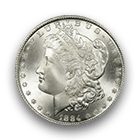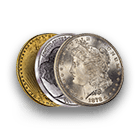With all of the talk about Lincoln Cents potentially being discontinued in 2025, many numismatists are turning to history to look for parallels that put the possible elimination of the coin widely known as the “penny” into a broader context. Historians need to turn the clock back to 1857 to find a similar scenario involving American copper coins, when both the half cent and large cent were eliminated - outmoded due to rising costs of production and inflation.
Click image to enlarge.
Click image to enlarge.
Sound familiar? It should… The Lincoln Cent presently costs about 3.7 cents to produce, and inflation over the past several years has severely diminished the buying power of a single cent. Not many things cost just one cent anymore – not even penny candy!
And it was back in 1857 that the cent had found itself in a similar situation. Yes, you could still buy many things for just a cent in the mid-1850s, but the coin was nearly the size of a modern half dollar. Therefore, carrying a lot of these cents around in a purse or pocket became cumbersome – especially as inflation even then was eating away at the purchasing power of the coin. That’s not even to speak of the cost of making large cents, each of which cost more than one cent to strike and distribute during the waning years of the coin’s existence.
That’s where the Coinage Act of 1857 comes into play. It authorized a number of changes to the everyday pocket change, including demonetizing foreign coins that had been considered legal tender in the United States, eliminating the half cent, and replacing the large cent with the small cent, which continued to be struck into 2025.
It’s important to emphasize that an act of Congress brought about these changes, and only an act of Congress can eliminate a United States denomination. Therefore, it would take Congressional approval to officially abolish the Lincoln cent – it can’t be banished by presidential decree or Treasury action alone. However, production could be suspended by way of the Treasury not ordering the U.S. Mint to produce new Lincoln Cents for circulation. That would be similar to the protocol exercised in placing circulation strikes of half dollars and dollar coins on hiatus.
And in 1857, the end of the large cent was met with the introduction of the Flying Eagle Cent. The incoming coin was struck in ample quantities of 17,450,000 – plenty to supply commerce with the brand-new small cent. This suppressed the need for vast numbers of the 1857 Braided Hair Large Cent – the last coin of its kind. Two iterations of the Braided Hair Large Cent were struck during the type’s final year, with one variation featuring a small date and the other exhibiting a large date. All 1857 Large Cents saw a cumulative mintage of 333,546 pieces, with PCGS CoinFacts reporting the large date to be “approximately twice as common as the small date.”
Both the 1857 Large Date Braided Hair Large Cent and 1857 Small Date Braided Hair Large Cent are considerably scarce – certainly much more so than most other large cents from the 1840s and 1850s. This, added with the demand for these last-year large cents, helps push up values for either the large date or small date varieties.
Both the large date and small date varieties are listed in the PCGS Price Guide for around $75 in G04, while a price spread appears in the grade of F12, where the large date trades for $160 and the small date fetches $175. In XF40, the large date goes for $285 while the small date takes $325, and in MS63BN the former goes for $775 and the latter garners $950. Examples in RB and RD are progressively rarer. The large date has a retail price of $2,000 in MS64RB and $25,000 in MS65RD. Meanwhile, the small date goes for $2,750 in MS64RB and $5,000 in MS64RD.









 Copper & Nickel
Copper & Nickel
 Silver Coins
Silver Coins
 Gold Coins
Gold Coins
 Commemoratives
Commemoratives
 Others
Others
 Bullion
Bullion
 World
World
 Coin Market
Coin Market
 Auctions
Auctions
 Coin Collecting
Coin Collecting
 PCGS News
PCGS News